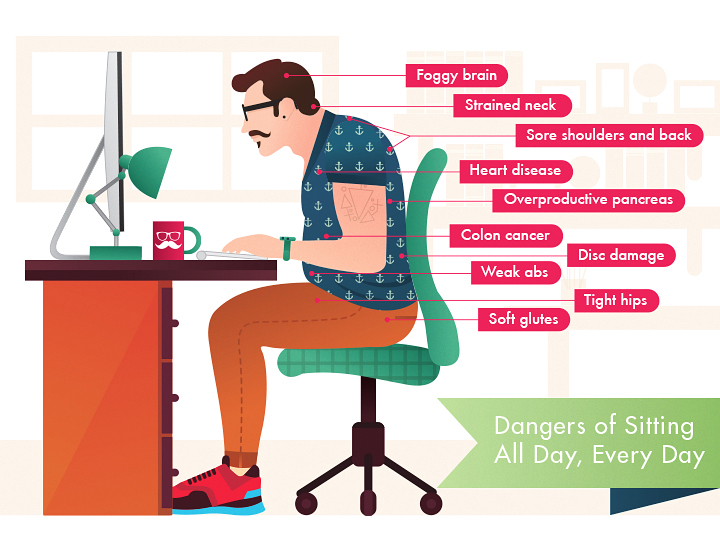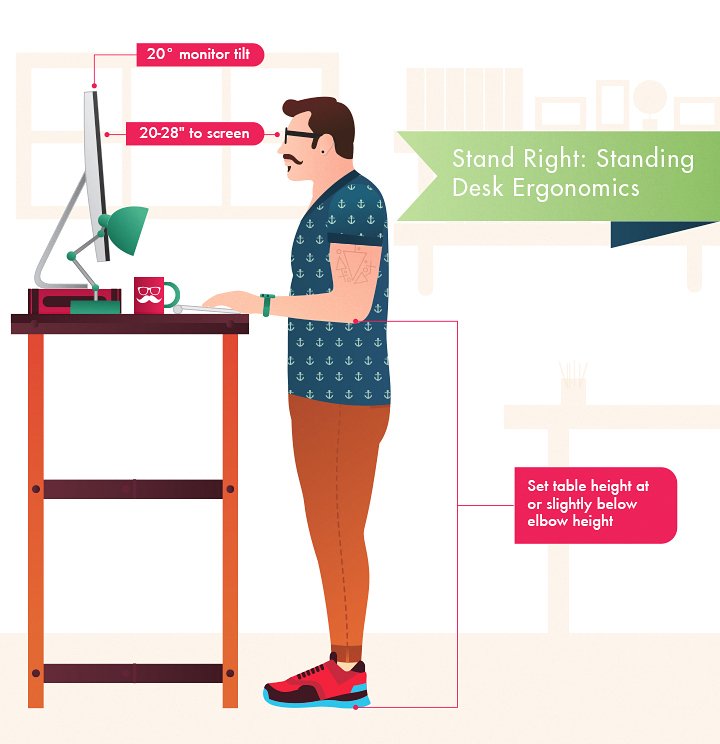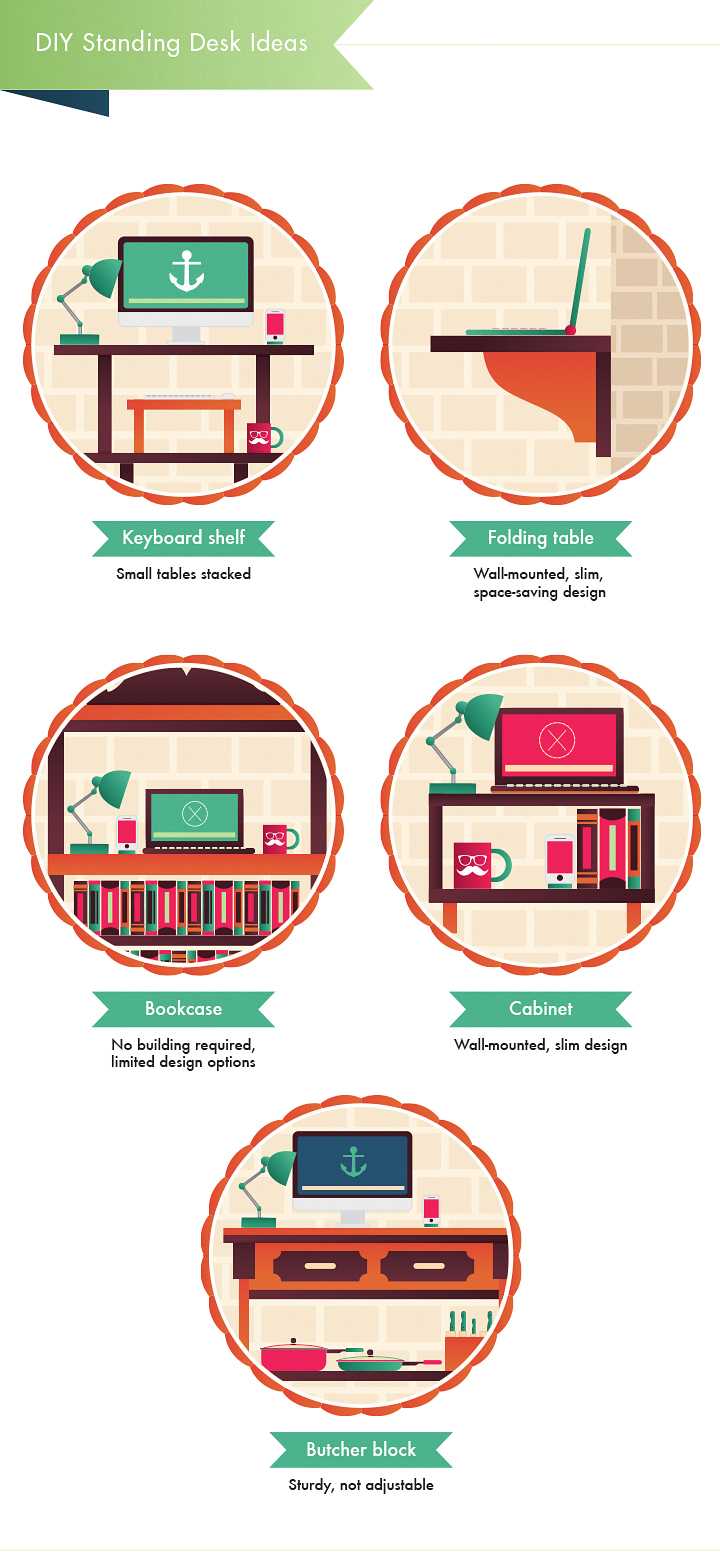
Written by J.H. Fearless
I get satisfaction of three kinds. One is creating something, one is being paid for it, and one is the feeling that I haven’t just been sitting on my ass all afternoon. ~ William F. Buckley, Jr.
DIY standing desk: Do away with the chair
Want to reinvent your workspace with something greener, more ergonomic, and better for your health?
You can design and build your own custom standing desk for a fraction of what a new product will cost. And as far as DIY projects go, this one is pretty easy. Whether it’s a multi-person desk, an at-home desk, or a reception desk, a desk is little more than a horizontal surface to work on, with a few added features for individual needs.
Why not create your own custom solution from upcycled or repurposed materials? To get started, here’s an overview of how a standing desk can improve your life, plus some of the best DIY ideas out there.
Don’t just sit there!
Standing desks have become popular over the past several years, particularly after a series of studies showed the serious health dangers associated with the modern American practice of sitting all day. While most people have always known we could all use a little more exercise, it wasn’t until recently that we realized how badly a sedentary lifestyle affects physical and mental wellbeing.
The moment a person sits at his desk each morning, his calorie-burning rate immediately drops to one calorie per minute. Sit for six hours a day, 14 days straight: Muscles stop burning fat, blood sugar rises, and maximum oxygen consumption drops, which makes it harder to move around and puts the body at greater risk for weight gain. After a year of sitting six hours per day, that weight gain would be noticeable, as would higher cholesterol levels and loss of bone mass.
But the real kicker comes 10 to 20 years down the line.
Those with a desk job may need to augment retirement savings to account for plenty of medical bills. Sitting affects almost every part of your body from head to toe, raises your risk of death by nearly 50 percent, and creates a stunning 125 percent increase in the risk for cardiovascular disease.
Dangers of sitting all day, every day
It’s possible you’ve heard standing desks are a superior alternative to the sitting kind, but the reality is slightly less cut and dried. Before tossing all the chairs in the house or office and committing to standing for the rest of your life, there are some important things to know.
Life standing up
When the standing desk craze first hit, a slew of reporters started testing the concept. Could standing to work improve energy and psychological well-being? Could it even improve writing, as it did for Hemingway? Multiple journalists set up standing desks and documented the experience. Surprisingly, these reports didn’t paint such a rosy picture.
Life is just too short to use a standing desk. ~ Business Insider
A Washington Post reporter actually lost sensation in her feet. Before long, research confirmed what many of us might assume: Standing all day sort of stinks.
In fact, ergonomic chairs were originally developed to prevent a handful of issues, including spine curvature, varicose veins, and backaches.
So what to do? Sit all day and die of a heart attack or stand all day and injure your legs and feet? The simple solution: a little bit of each. A 2011 CDC study confirmed that “sit-stand” desks, which allowed users to vary their position, effectively reduced back and neck pain as well as improved people’s mood.
Movement and ergonomics
The concept is simple: Our bodies were built to move and they don’t want to be still all the time. Standing desks are superior to sitting desks in improving posture, but more importantly, they make it easier to move—to shift weight from foot to foot, turn around for a conversation, and even walk away.
Incorporating some type of movement (or the possibility to change position) can lead to standing-desk benefits. Most importantly, blood circulates correctly, reducing the risk of all those diseases mentioned above (including the increase in mortality rates). Adding some movement to your day can even burn extra calories, making it easier to lose weight.
 This is an important idea to incorporate into a DIY standing desk setup. Because DIY allows for more individual design opportunities, you can choose to make it sit-stand adjustable if you wish. Or, build it as an addition to a sitting desk so you can switch back and forth. You can even build a treadmill desk if you’re ambitious.
This is an important idea to incorporate into a DIY standing desk setup. Because DIY allows for more individual design opportunities, you can choose to make it sit-stand adjustable if you wish. Or, build it as an addition to a sitting desk so you can switch back and forth. You can even build a treadmill desk if you’re ambitious.
One more crucial element to consider: ergonomics. Just like a sitting desk, a poorly designed standing desk can cause lasting injuries from repetitive movements. Wherever you can, add in the ability to adjust angles and heights. A standing desk should be positioned so you can stand comfortably—possibly on an anti-strain gel mat—and so your arms rest at a natural 90-degree angle, with your elbows close to the body and without twisting at the wrist.
Stand right: Standing desk ergonomics
Once you’ve got the ergonomics right, and have the opportunity to move, you’ve got a standing desk that will likely make you feel invigorated and engaged even after a long day. Better yet, this desk will better meet your exact preferences when compared to commercial versions.
Why DIY?
If you’ve been considering the switch to standing, you’ve probably made an uncomfortable discovery. A new standing desk can set a buyer back hundreds, sometimes thousands, of dollars. And since standing desks are relatively new, it won’t be easy to buy a previously used model. Creating a custom DIY desk is an obvious money-saving solution. The savings can verge on extreme. One of the designs we’ll cover below costs less than $25. But no matter what style of desk you plan to build, the odds are high that you’ll save a big chunk of cash.
When you design and build your own desk, you have the opportunity to create something that will work for personal space, work style, and aesthetic. There’s also the option to make a greener choice by avoiding brand-new products. All of the desks below are designed using upcycled and repurposed materials. It’s a win-win-win situation: save money, respect the environment, and build something that fits your style. Small wonder that in a recent Lifehacker poll, DIY standing desks came out as a clear winner over all pre-made competitors.
The best DIY standing desk ideas
Let’s start with the basics. The cleverly named Standdesk 2200 can be built right on top of an existing desk. It’s mind-bendingly simple. Place a small table on top of the desk, then attach a shelf for a keyboard. The prototype cost the inventor just $22. A quick repurpose of a used table and/or shelf could probably shave that figure down significantly. The downsides: Nothing about this setup is adjustable, it doesn’t provide the option to adjust posture, and it may not be the most stylish.
If the simplicity of that solution is enticing but the ability to switch between standing and sitting is a must-have, there are a few DIY standing desk designs that can be easily incorporated into an existing office space without forcing users to ditch a seated desk. Space-conscious designs—like this repurposed folding table and this converted bookcase—won’t take up much room or intrude on a room’s feng shui, but they’re essentially just small shelves. For a more adjustable and work-friendly option, try building a basic open cabinet (a perfect way to repurpose and give new life to old wood) and add an adjustable keyboard tray. Again, none of these ideas are particularly stylish or spacious, but we’re just getting started.
If space isn’t an issue or a bigger desktop is a necessity, the giant-table concept may be a more ideal option. There are a lot of potential variations in complexity and design, but the underlying idea is the same: a large, sturdy desktop on long legs. Feel free to experiment with the materials you have on hand rather than buying new ones. If you have access to a couple of sawhorses and an old door or countertop, it’s easy to make an incredibly simple yet height-adjustable, rustic standing desk. Looking to make use of scrap lumber? Build an all-wood desk or even make your own butcher block desktop.
Finally, you can repurpose and upcycle old shelving units, crates, tables, and other useful items to mastermind a custom standing desk design. Though seated desks are horizontally oriented, don’t forget to think vertical when making the switch to standing. There’s lots of real estate below a desktop for items including a printer shelf, a storage cabinet, and other office supplies you may want to tuck away. Be creative!

DIY sit-stand and treadmill desks
If you’re up for a bit of a challenge and really want to incorporate movement and flexibility into your workspace, try building a DIY sit/stand desk or even a treadmill desk. Instead of taking breaks to walk around or switching from a standing workspace to a seated one, you can stick with one well-designed desk that does it all.
Some of the best DIY sit-stand desk designs are also well suited to repurposing and upcycling. Use pipes and kee clamps to create a telescoping base for the desk, then add any type of desktop you like. Or repurpose an old adjustable-height table, adding the legs to the desktop for a piece that suits your style and your workspace. You can even make a three-position rolling desk that doubles as a coffee table.
I can personally recommend the treadmill desk concept, having built my own for about $150 (all of it was put toward a used treadmill purchased locally). The treadmill has long “arms,” which made the ideal base for a desktop made from a reused wood plank. I added two U-bolts for stability, bolted a laptop stand to the desk, and was walking and working right away.
A little creativity goes a long way
Realistically, with a little creativity and some good materials there are no limits to standing desks. A desk is, after all, just a horizontal surface that makes it easier to do work. Get creative with it. Hack your space, hack your materials, and have fun repurposing not just your office, but your whole workday to create a healthier, greener, more invigorating experience.
Infographics courtesy custommade.com
Bonus:
Listen to the latest Green Divas DIY podcast!
Listen to the latest Green Divas Radio Show—and other green and healthy living podcasts—daily on GDGDRadio.com (or get the GDGD Radio app)!
 J.H. Fearless is a blogger and writer whose work explores the intersection of art, nature and culture. Her blog, “Uprooted,” won the Tripbase Eco-Travel blog award in 2009 and 2011. Her work has been featured in The Huffington Post, Burning Man, National Geographic’s Green Living Website, Sharable and many more notable publications. Currently, she lives in Reno, Nevada, where she spends her time learning to garden in the desert and blogging for Burning Man each September. You can connect with J.H. on twitter @jhfearless and Facebook.
J.H. Fearless is a blogger and writer whose work explores the intersection of art, nature and culture. Her blog, “Uprooted,” won the Tripbase Eco-Travel blog award in 2009 and 2011. Her work has been featured in The Huffington Post, Burning Man, National Geographic’s Green Living Website, Sharable and many more notable publications. Currently, she lives in Reno, Nevada, where she spends her time learning to garden in the desert and blogging for Burning Man each September. You can connect with J.H. on twitter @jhfearless and Facebook.
[dynamic-sidebar id=’Custom Widget 2′]
Lauraine Alexis
October 17, 2022 at 2:07 am
Hi green diva’s ,great message sending, a lot of health issues can be addresed when you use a adjustable-standing desk from your home based work to office. It Improves posture and lessens back pains from stressful work. I like it much